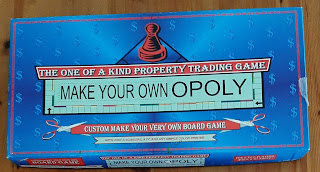Make Your Own Opoly

Following up on the last article, the same day I found the 1972 British edition of Monopoly, I also grabbed what seemed like and oddity, called Make Your Own Opoly. I never cared for all of those themed, skinned editions of Monopoly. It was a bit amusing early on, but now every state and town has an edition of their own, every major TV show, movie editions, Star Wars, Simpsons, Las Vegas, Harry Potter ... argh. Sometimes it's nice to see a store have a section labeled "Games" only to have it be just 20 or 30 funky clones of Monopoly, as if there was nothing else available in the world. So this one just struck me as odd. Early on in my programming career, about the first project I would do to learn a new language would be a few bits of D&D (of course) and then a simple board game, almost always Monopoly, because it was so universal and had a good variety of features (board, cards, money, properties) to write code for. Back in the shareware days, I had a clone ...


